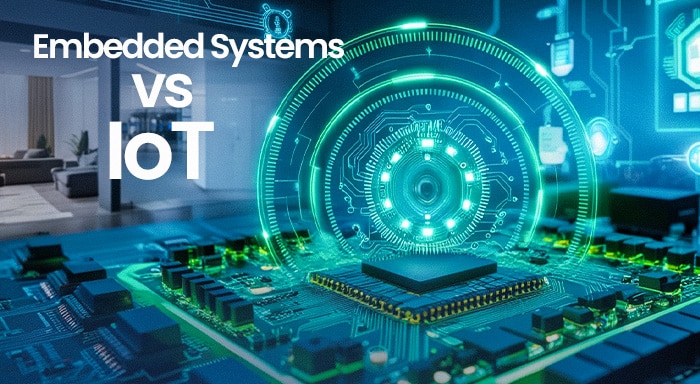The Internet of Things (IoT) and embedded systems are well-known sophisticated tools in the ever-changing digital world. These technologies are agents of transformation that reshape how industries drive innovations. While these terms share a foundation for each other, they serve distinct features and have unique characteristics. IoT represents an interconnected network of physical objects like fitness tracking watches, smart refrigerators, and other appliances to the Internet. These devices interact with each other to collect and exchange information using wireless technologies like WiFi, Bluetooth, and cellular networks.
Moreover, embedded systems are computer systems designated to perform a few dedicated tasks on larger systems. These systems interact with users through a dedicated interface, typically operating in the background. In this blog, we will see the definition, roles, features, and key differences between IoT devices and embedded systems. Through this comprehensive blog, you have a better understanding of how they transform our increasingly complex world.
Understanding IoT and Embedded Systems
What is IoT
IoT, abbreviated as the Internet of Things, is an interconnected network of physical devices integrated with sensors, actuators, and other technologies. These networks enable them to communicate, collect, and transmit data with other devices in real-time over the network. Therefore, multiple layers of IoT architecture are responsible for creating a secure and functional system. IoT can empower the capabilities of embedded systems by allowing them to communicate, collect, and exchange data. These technologies can together expedite an efficient and more responsible environment.
Common Examples of IoT Devices
Smart Home Devices: smart doors, security cameras, lighting systems, and smart thermostats.
Agriculture: weather monitoring systems using IoT, smart irrigation systems, etc.
HealthCare: disease detection systems, equipment tracking, remote patient monitoring systems.
Wearable technology: fitness trackers, smartwatches, and smart glasses.
Industrial Devices: industrial IoT (IIoT) sensors and remote monitoring systems.
Key Characteristics of IoT
- Integration: IoT systems often integrate with cloud services for data storage and remote access and sensors for data collection. Additionally, this system integrates with artificial intelligence to automate process and communication protocols for secure communication across various applications.
- Scalability: From individual devices to massive networks, IoT architectures are designed to manage increased device numbers while maintaining the quality of performance.
- Connectivity: This enables IoT devices to essentially connect with other devices, networks, clouds, and central systems. This connection facilitates the communication and data exchange between each other.
- Data Collection: IoT systems collect data from physical environments using IoT sensors and user inputs. This information is then transmitted to central systems for analysis using various data collection methods.
What are Embedded Systems?
At its core, an embedded system serves as a foundation or subset for IoT devices. This system is designed to perform a specific task within a larger system, like a mechanical or electrical system. Meanwhile, these computing systems consist of hardware and software components, like a microprocessor and microcontroller. They provide real-time insights and enhance the overall credibility and efficiency of the system, unlike general-purpose computers.
Common Examples of Embedded Systems
- Automotive Systems: anti-lock braking systems, engine control systems, and auto-driving assistance systems.
- Industrial Systems: robotic arms, sensor monitoring systems, and assembly control systems.
- Healthcare: imaging and MRI machines, pacemakers, and insulin pumps.
- Home Appliances: washing machines, dishwashers, and microwave ovens.
Key Characteristics of Embedded Systems
Real-time Analysis: Various embedded systems perform tasks in a real-time environment, which means tasks are executed within specific time constraints. However, it is crucial for the vehicle and healthcare industries, where timely responses ensure safety and smooth functionalities.
Resource Constraints: these systems operate with limited processing capabilities, including memory, energy power, and processing power. It optimizes the design to make it effective and meets high-performance rate and cost requirements.
Longer Lifespan: Many embedded systems function for a long time, eliminating the need for regular maintenance and updates. This system ensures reliability and credibility, which means the system often functions in the case of failure.
What is an Embedded system in IoT?
The synergy of IoT systems and embedded systems has brought the term “IoT embedded systems.” Generally, these are the embedded systems connected to the internet, enabling them to perform tasks within the IoT ecosystem. This convergence facilitates advanced functionalities, including IoT remote control, monitoring, complex data analytics, and data sharing capabilities. Additionally, it eliminates the gap between standalone operations and unified or interrelated intelligence of IoT.
IoT embedded systems usually consist of several components of IoT, including:
- Connectivity Layer: The system utilizes various communication channels like WiFi, LoWPAN, Bluetooth, and cellular networks.
- Hardware Layer: incorporate power management systems, microcontrollers, microprocessors, sensors, and actuators in IoT embedded systems.
- Software Layer: operating system (OS), application software, and firmware.
- Security Layers: Leverages various IoT protocols like MQTT, CoAP, and SSH in IoT environment for encryption, authentication and security of the system.
Embedded Systems vs IoT: Key Difference
Despite the combined characteristics and individual roles of IoT embedded systems, it is also crucial to understand the major differences between them. These distinctions help you clarify their individual roles and applications to leverage their capabilities tailored to your needs. As well as how they complement each other in a sophisticated technological world.
Communication and Connectivity:
Embedded Systems: Usually operate independently and within a closed network using limited communication capabilities. The system often utilizes protocols with or without network connectivity to perform specific tasks.
Internet of Things: on the other hand, IoT relies on internet connectivity and focuses on network-driven devices for seamless data exchange and remote monitoring. The network allows the system to interact with other IoT devices, cloud services, and the central network throughout the levels of IoT implementation.
Data Collection and Management:
Embedded Systems: These systems require minimal storage and offer limited resources, such as power, memory, and storage. Embedded systems typically use embedded databases to store, access, and process data with a local network.
Internet of Things: Conversely, IoT gathers, processes, and exchanges data by analyzing vast amounts of data from interconnected devices. It uses cloud infrastructure and edge computing to manage real-time data insights and data storage.
Scope and purpose:
Embedded Systems: This computing system focuses on isolated tasks within the network efficiently. However, the scope of embedded systems typically depends on the lifespan of particular functions.
Internet of Things: IoT aims to connect a guide ecosystem, allowing devices to collect, share, and analyze data in real-time. Although it has a broader scope by enabling a wide range of systems to contribute and perform localized tasks.
Update and Maintenance:
Embedded Systems: These systems are typically operated on a single software throughout their lifecycle with fixed functionality and limited updates. If these systems address security issues and software bugs, implement secure boot mechanisms and OTA (over-the-air) updates.
Internet of Things: IoT often comes with remote update capabilities like over-the-air updates, firmware updates, and software patches. In essence, these updates keep systems secure and functional and prevent downtime.
Final Verdict
Embedded systems and IoT technology both complement each other and rapidly drive innovations across multiple domains. While embedded systems focus on isolated tasks within the network, IoT brings advanced capabilities by enabling scalability and connectivity. Despite its broad potential, the role of embedded systems in overcoming the challenges of IoT is not negligible. Meanwhile, understanding the difference between IoT and embedded systems is as crucial as understanding their synergy for building an efficient solution. Irrespective of whether you are a developer, a business, or an individual looking to leverage these technologies to streamline your routine workflow



